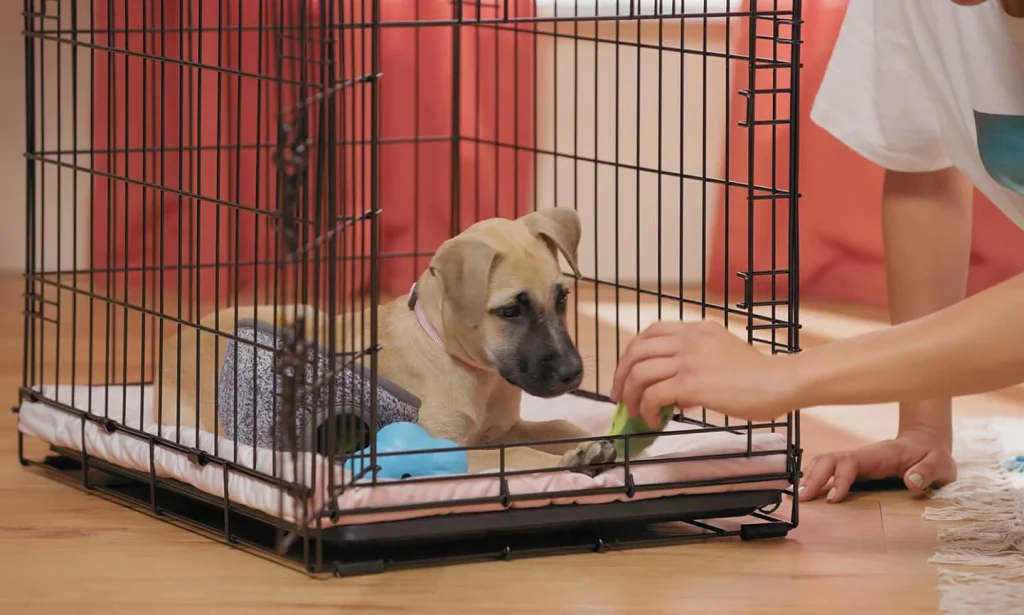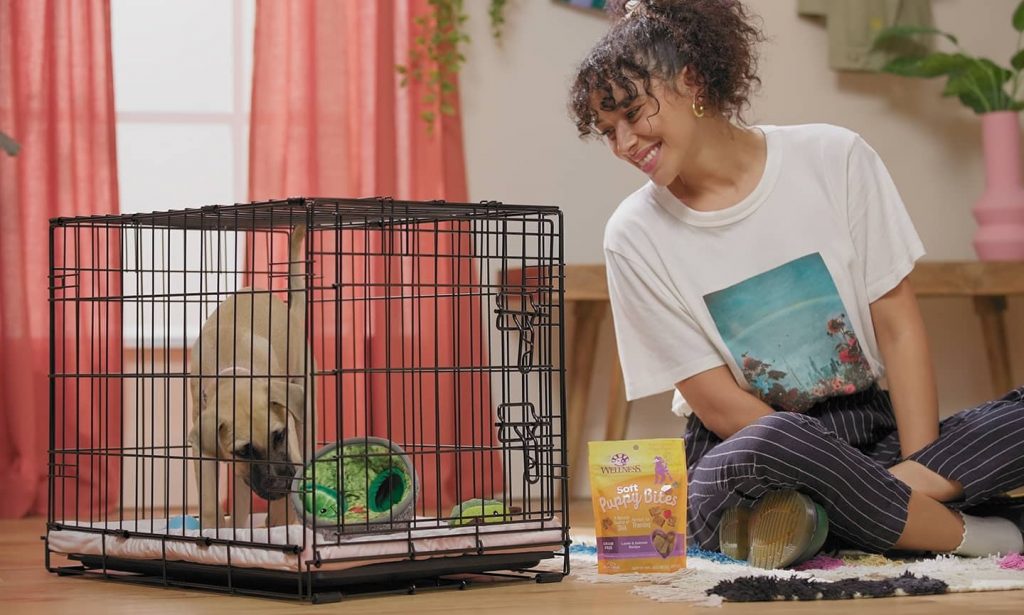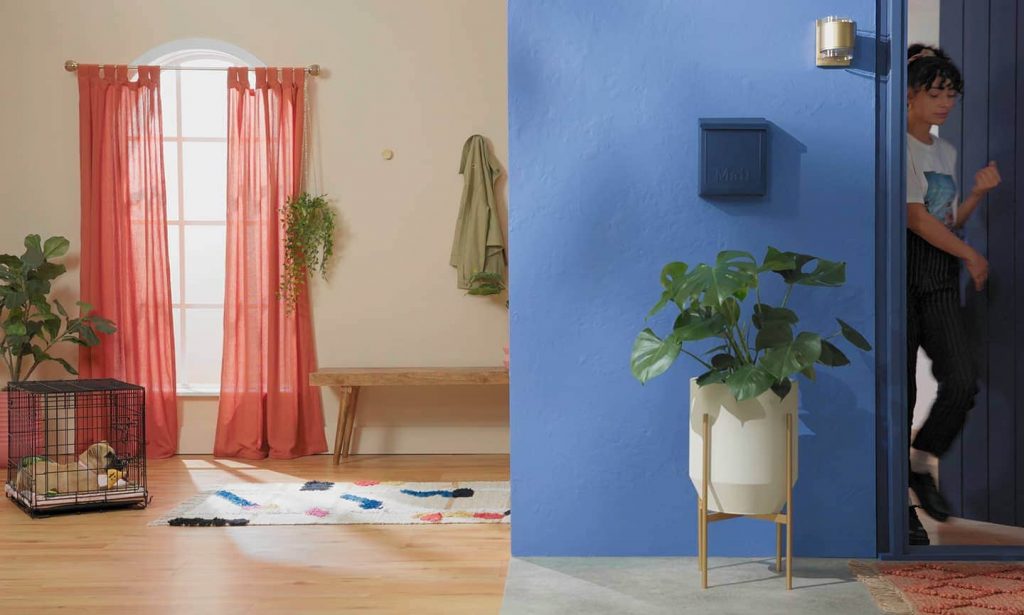If you’ve just brought home a new dog, potty training is probably high on your list of priorities. What if we told you there’s a way to simplify the housetraining process and help your pup feel calm and secure at the same time? It’s true—and it’s all about crate training.
What is crate training? It’s the process of helping your dog learn to spend time in their crate—and ultimately, to adopt it as their own personal space in your home. Crate training taps into your pup’s natural inclination to keep their sleeping space clean—they’re less likely to go potty where they hang out and sleep. Using a crate has benefits beyond just potty training, too; it also helps to keep your dog safe and out of mischief when you’re not around to supervise them, plus it provides a comfy retreat when household hubbub gets overwhelming and your pup wants to relax.
But there’s more to crate training a dog than simply putting them in the crate and closing the door. Dogs need to gradually adjust to spending time in their crates, with lots of positive encouragement from you. Rush the process, and you’ll risk causing your pup stress and anxiety, which can create negative associations with the crate that can be difficult to overcome.
So how do you crate train a dog, and what do you need to know to get started? We’ve got your complete guide to crate training a dog.
Your dog’s crate might look like a basic enclosure to you, but if you use it correctly, it’ll become one of your pup’s favorite places to be—aside from your lap, of course. Here’s how crates can help both you and your dog:
Some pet parents worry that “locking their dog up” in a crate could be cruel, but the reality is far different. Yes, one benefit of crates is indeed that they keep your dog contained (and out of mischief). But when used properly, your dog’s crate won’t feel like a cage. In fact, it’ll feel just like home! The trick is to introduce the crate gradually, without rushing your dog to adjust to it before you leave them in it alone. Let them settle into the crate on their own terms, and your pup will repay you with a calm and happy crate time for years to come.
If you want your dog’s crate to become their happy place, you’ve got to make sure it’s just right for them. Here’s what you’ll need:
Once you start to look at crates you will find there are lots of options. Choosing the right crate for your pup isn’t difficult once you consider a couple of things:
First up is the type of crate, which can fall into two categories: either hard plastic airline-style crates or wire crates. Most pups can learn to be comfortable in either type, but wire crates have more versatility when it comes to door placement and customizing the size of the interior with a divider.
Next, you’ll need to pick the correct size—one of the most important considerations when figuring out how to crate train a dog. Your dog crate should be large enough so that your dog can stand up, turn around and lie down comfortably, but not much bigger. Although it’s tempting to purchase an oversized crate to give your pup more room, doing so can derail the potty-training process by giving your pup the space to go to the bathroom at one end while staying dry on the other.
Pet parents of puppies, especially large breed puppies, can anticipate their dog’s growth by purchasing the largest-sized crate their dog will need when they’re fully grown and using an adjustable crate divider to keep the available space inside the right size. Some dog crates come with a divider and are available in sizes up to XL, so your crate can grow right along with your puppy.
There’s more to crate training than just a crate. Here’s what else you’ll need:
The perfect spot for a dog crate is a location that’s quiet enough for your pup to rest but not so far off that they’re isolated from the household (so the garage or the basement are out). A corner of the living room, dining room, or another area where the family regularly gathers is an ideal location.
Crate location is particularly important at night, especially for young puppies who often need to go out for a potty trip at least once before morning. You’ll want to put the crate close enough to your bed that you can hear them ask to go out—and somewhere easy for you to get to, so you don’t have to fumble around in the middle of the night. If keeping the crate in your bedroom isn’t an option, consider using a dog monitor near the crate so you can hear when your puppy needs a potty trip.
It can be helpful to purchase two crates, especially for pet parents with larger dogs who require oversized crates that aren’t easy to move around. Keep one in the common area where your pup will hang out during the day, and one where they sleep at night.
One of the secrets to kennel training success is giving your dog plenty of time to feel comfortable inside the crate before closing the door and leaving them alone for the first time. The goal is for your pup to have a positive association with being inside so that the crate feels like a safe and comfortable resting spot—and you can’t rush that feeling. So remember: The steps below aren’t meant to be done all in one day. Spend as much time as you need on each step to ensure that your dog feels content and stress-free. That’s how you lay the foundation for a lifetime of looking forward to their crate.
Ready to dive into crate training? Here’s how it’s done.

Start off the crate training process by keeping the crate door open and letting your pup explore it at their own pace. Toss a treat inside and praise your dog when they go in to eat it, then give them another while they’re in the crate. You can also entice your dog with a busy toy stuffed with treats—anything to make that crate as appealing as possible! Stay happy and upbeat as your puppy explores the crate, making sure to give lots of praise when they go inside. At this stage, keep the door open.
Practice this step as many times as necessary for your dog to get comfortable in the crate. At this stage, the choice to go into the crate is up to your pup. Don’t force them if they seem reluctant. If your dog is hesitant to go inside, you can give treats to reward baby steps in the right direction, like if they glance at it or take a step towards it. These small successes will encourage your pup to keep it up! If they don’t get close to it, simply leave the treats inside for them to collect when they’re ready.

Once your pup has made a positive association with going into the crate, they’ll be ready for slightly longer sessions inside. First, have a play session with your dog and take them outside for a potty break—that’ll help them settle down when it’s crate time. Then, provide a lightly stuffed busy toy for them to enjoy inside the crate. Stay nearby as they enjoy the goodies, and experiment with closing the door while your pup is enjoying the toys and treats inside. Let your dog out right after they finish the treats, or at any barking, whimpering, or pawing at the crate that might indicate they want to come out. Again, keep at this step until your dog seems relaxed and shows no signs of stress inside the crate.


The following simple tips can help speed the crate training process:
If your dog still isn’t settling into the crate, they may be experiencing separation anxiety or discomfort. Check out our tips on dealing with dog separation anxiety and puppy separation anxiety in particular, and talk to your vet for advice tailored to your unique pup.
But if you follow these tips, chances are that before long, your puppy will begin to happily settle into their crate with ease—and that’s a big life improvement both for them and for you.
If you’ve found this page helpful, please consider leaving a small donation to help us to create more useful advice.
You can also sign up for our free newsletter for more tips and tricks, and to keep up to date with our work.
| Cookie | Duration | Description |
|---|---|---|
| cookielawinfo-checkbox-analytics | 11 months | This cookie is set by GDPR Cookie Consent plugin. The cookie is used to store the user consent for the cookies in the category "Analytics". |
| cookielawinfo-checkbox-functional | 11 months | The cookie is set by GDPR cookie consent to record the user consent for the cookies in the category "Functional". |
| cookielawinfo-checkbox-necessary | 11 months | This cookie is set by GDPR Cookie Consent plugin. The cookies is used to store the user consent for the cookies in the category "Necessary". |
| cookielawinfo-checkbox-others | 11 months | This cookie is set by GDPR Cookie Consent plugin. The cookie is used to store the user consent for the cookies in the category "Other. |
| cookielawinfo-checkbox-performance | 11 months | This cookie is set by GDPR Cookie Consent plugin. The cookie is used to store the user consent for the cookies in the category "Performance". |
| viewed_cookie_policy | 11 months | The cookie is set by the GDPR Cookie Consent plugin and is used to store whether or not user has consented to the use of cookies. It does not store any personal data. |